When it comes to calculating the cost of operating your HVAC system, there are multiple variables at play. These include where you live, the cost of electricity in your area, the age of your HVAC system and unit, and the measures you take to keep your system running efficiently.
So, while we can’t give you a quick and easy answer, if you are wondering exactly how much an HVAC unit adds to your electric bill, we can help you learn how to calculate the cost for yourself. And taking a minute to do so is well worth your time, as heating and cooling your home impacts your power bill greatly. In fact, the US Department of Energy reports that 48 percent of Americans’ home energy use goes to keeping their homes at a comfortable temperature.
This article will detail how to calculate the cost of running your HVAC system and offer tips on cutting costs, so you can live comfortably without draining your bank account each month to do so.
Calculating the cost
If you want to calculate the actual cost of running your HVAC system so you know how much running your HVAC affects your power bill, you can make a close estimate by doing some calculations.
Here’s a simple process to get the cost of running your HVAC system per day:
- HVAC unit’s wattage x running time per day = Your HVAC unit’s Kilowatt-hours (kWh)
- kWh x the cost per kilowatt hours .
Let’s break this process down!
First, Discover your HVAC Unit’s Wattage and Daily Running Time
HVAC Unit Wattage
You first need to find out the wattage of your HVAC unit—how many watts your HVAC unit consumes while running. This information might be on a sticker on the unit itself or in the paperwork that came with the unit when it was installed. You can also Google your HVAC system with all its specifications if you can’t find it anywhere else.
Daily Running Time
Then, you’ll need to figure out how long your system runs daily. You can estimate running time by tracking the minutes your system turns on in one hour and multiplying by 24 (hours) to figure out the number of hours it runs in one day. Some smart thermostats actually track the system’s running time for you, so you might be able to skip the math if your thermostat has already done the job!
Determine Your HVAC Unit’s Kilowatt-Hours.
Next, convert the wattage into kilowatts and multiply by the number of hours your unit runs. This number is your HVAC unit’s kilowatt-hours
The Final Equation: Arriving at The Daily Cost to Run Your HVAC Unit
The moment we’ve all been waiting for! All that’s left to do is multiply your HVAC unit’s kWh by the current price of electricity per kWh, which will give you a rough estimate of how much you spend every day to run your HVAC system.
Compare Results of Your Calculations To Your Current Energy Bill
As stated at the beginning of this article, nearly half of the average American home’s energy bill is devoted to HVAC operation. This is a national average and doesn’t mean this is what your bill should or will look like. But, if you do your calculations and find that you’re spending far more than half your energy bill on HVAC operation, you may want to investigate further to find out what’s going on.
Tips for cutting costs
Because the cost of running your AC unit or heating system is a given, it’s smart to consider ways to make your HVAC system run more efficiently. Actions ranging from simple tricks to investing in larger projects can help you cut down on those regular HVAC bills.
First, consider some simple adjustments you can make that will go a long way with your power bill. For example, keep the thermostat temperature set at a comfortable, yet economical level. For the summer, think around 75 or higher. For the winter, think around 68 or lower. Other ideas include using an energy-efficient space heater, using fans to circulate air (regardless of the season), and taking advantage of energy-saving window curtains.
If you don’t want to make any sacrifices to your comfort by turning the thermostat up or down to save money, there are other ways to help your HVAC system do its job while keeping costs down. These include:
- checking on the type of insulation you have in your attic,
- examining your ductwork to make sure it has no leaks,
- making sure the filters in your system are cleaned or changed regularly,
- getting a new smart thermostat that is programmable.
- Having your system tuned up yearly to make sure it is working as efficiently as possible.
All these actions can make your system cost less and keep your energy bill reasonable. Whether you are satisfied with the state of your current utility bills, or you are desperately seeking ways to lower them, it’s always a good idea to review the many ways your HVAC system could be wasting energy. Why? Because any amount of wasted energy is wasted money!
Call us
Exxel Mechanical serves a wide area of central Maryland, including Mount Airy, Westminster, Owings Mills, Ellicott City, and Frederick. Our reputation in this area precedes us, as we pride ourselves on placing our customers as our highest priority.
Our professionals have seen it all and we have plenty of ideas for ways to make sure your heating and cooling systems are working as efficiently and cost-effectively as possible. We want you to be comfortable and save as much money as possible.
Call (443) 821-1040 or email [email protected]


